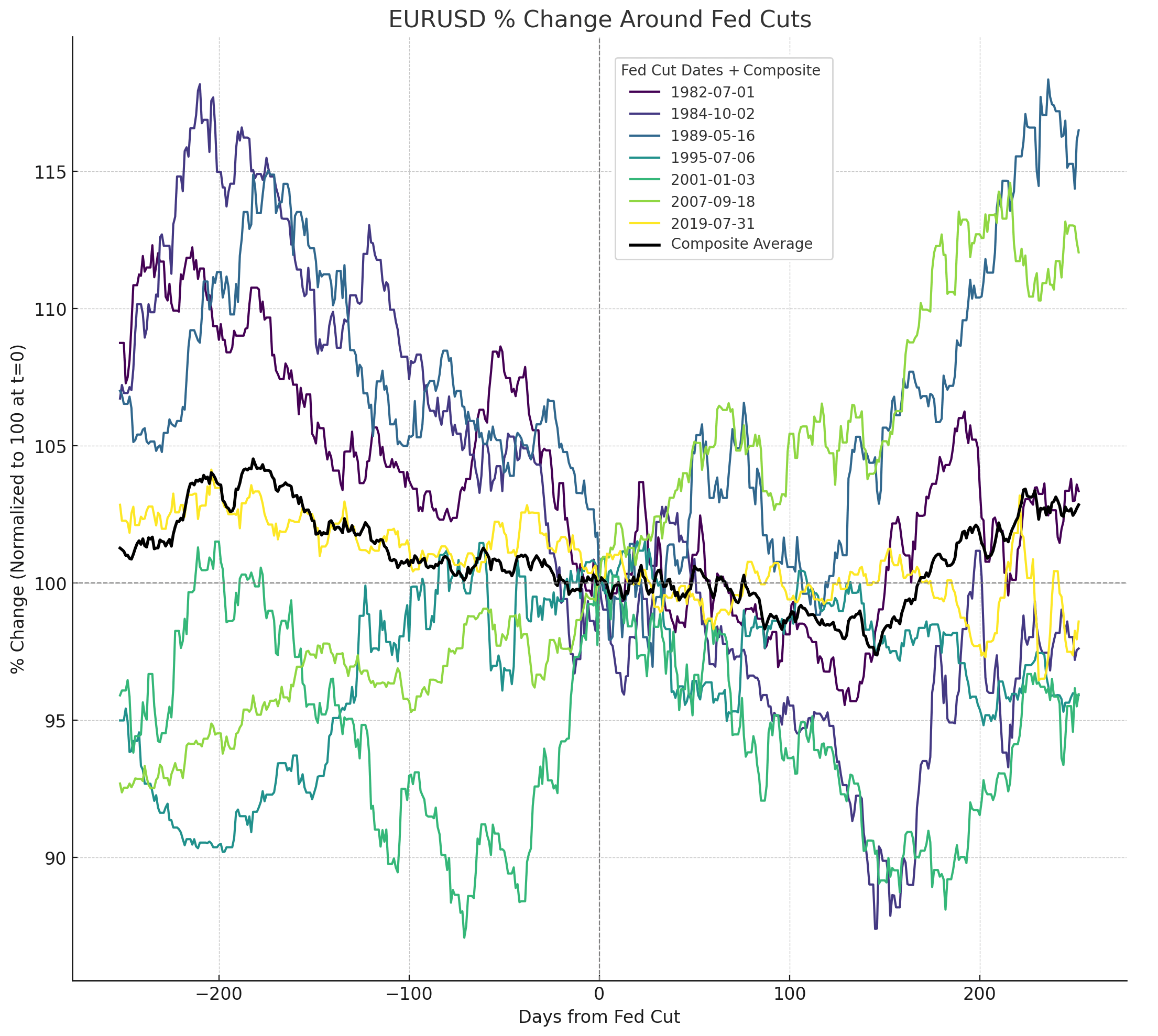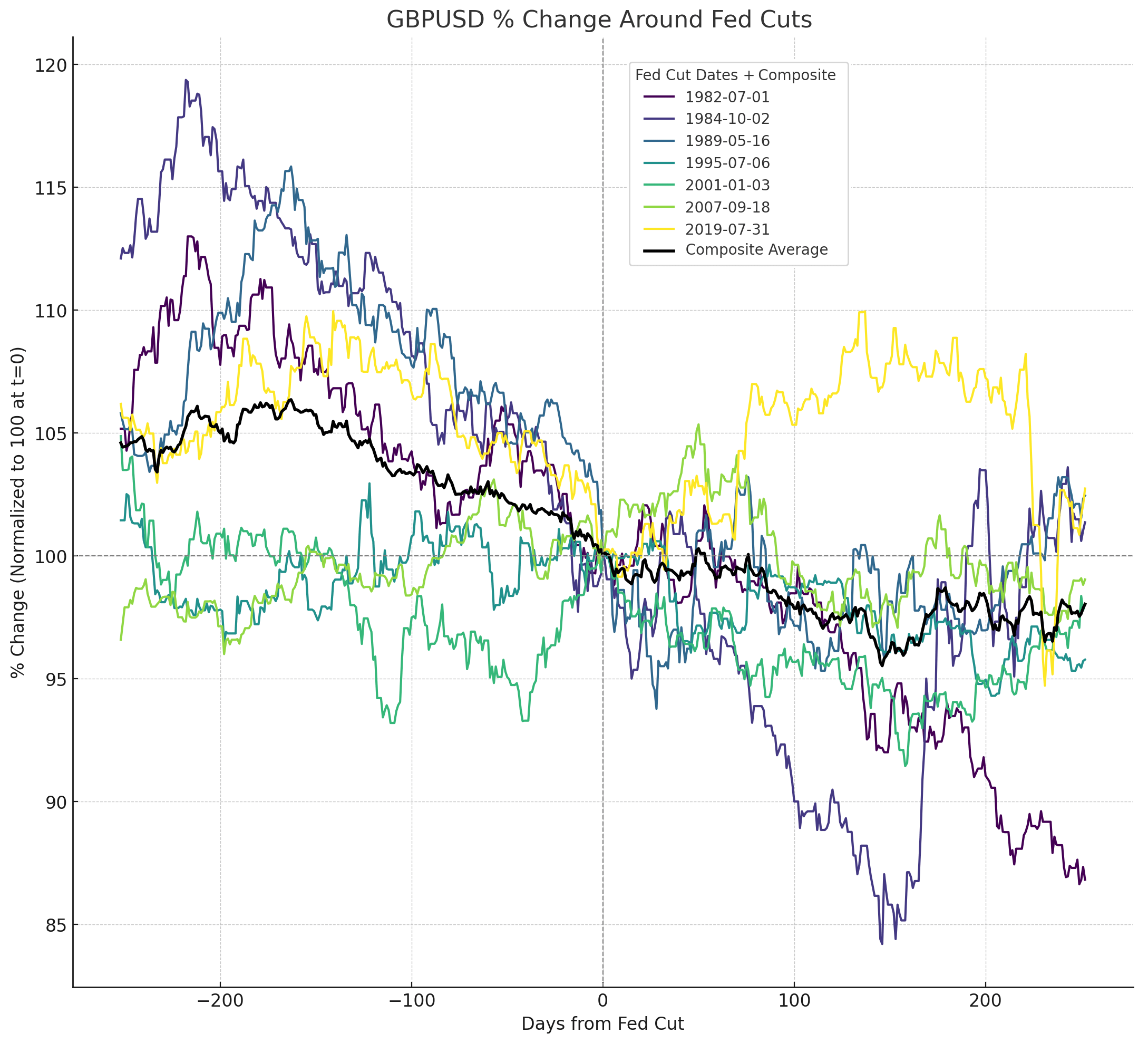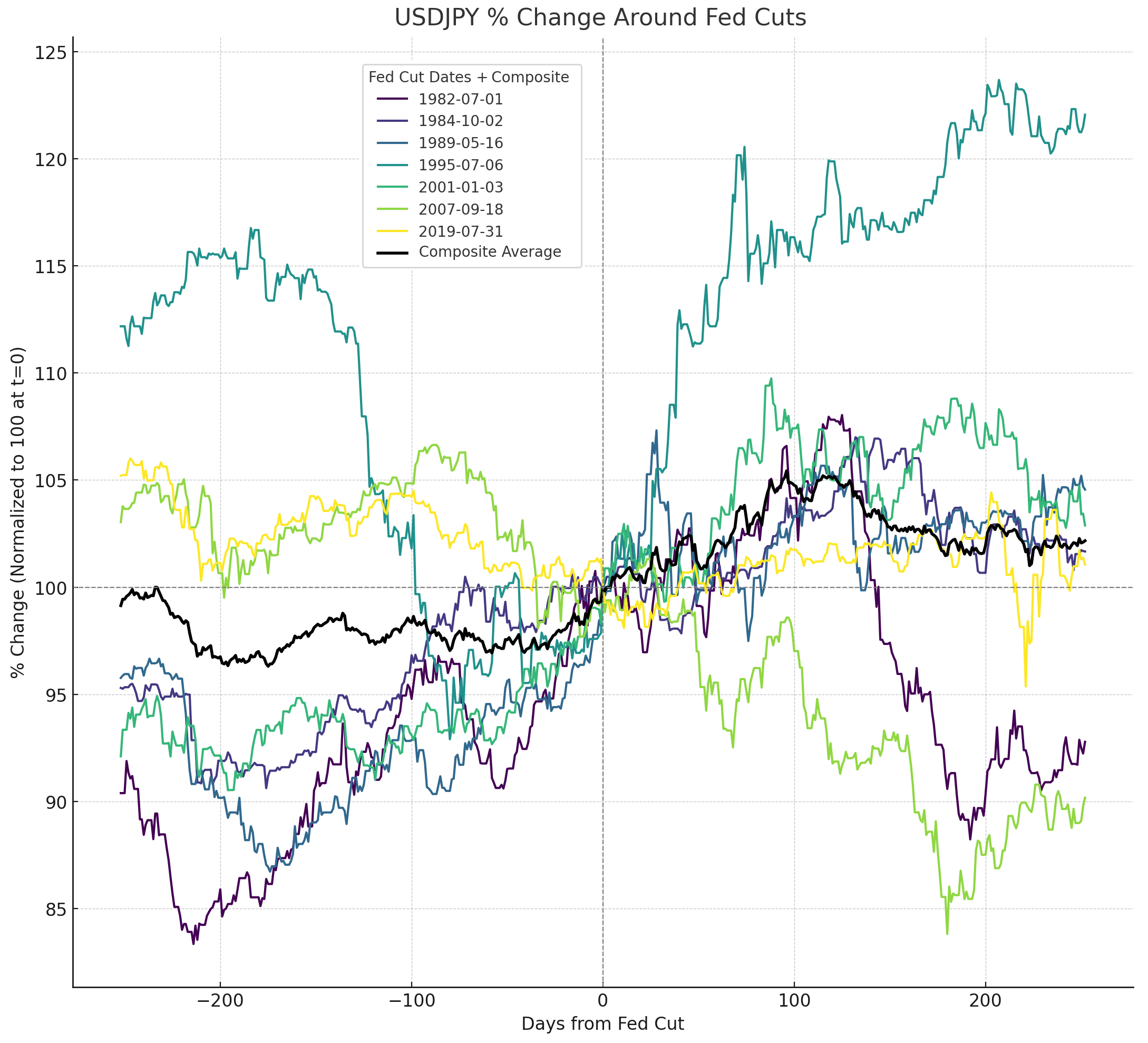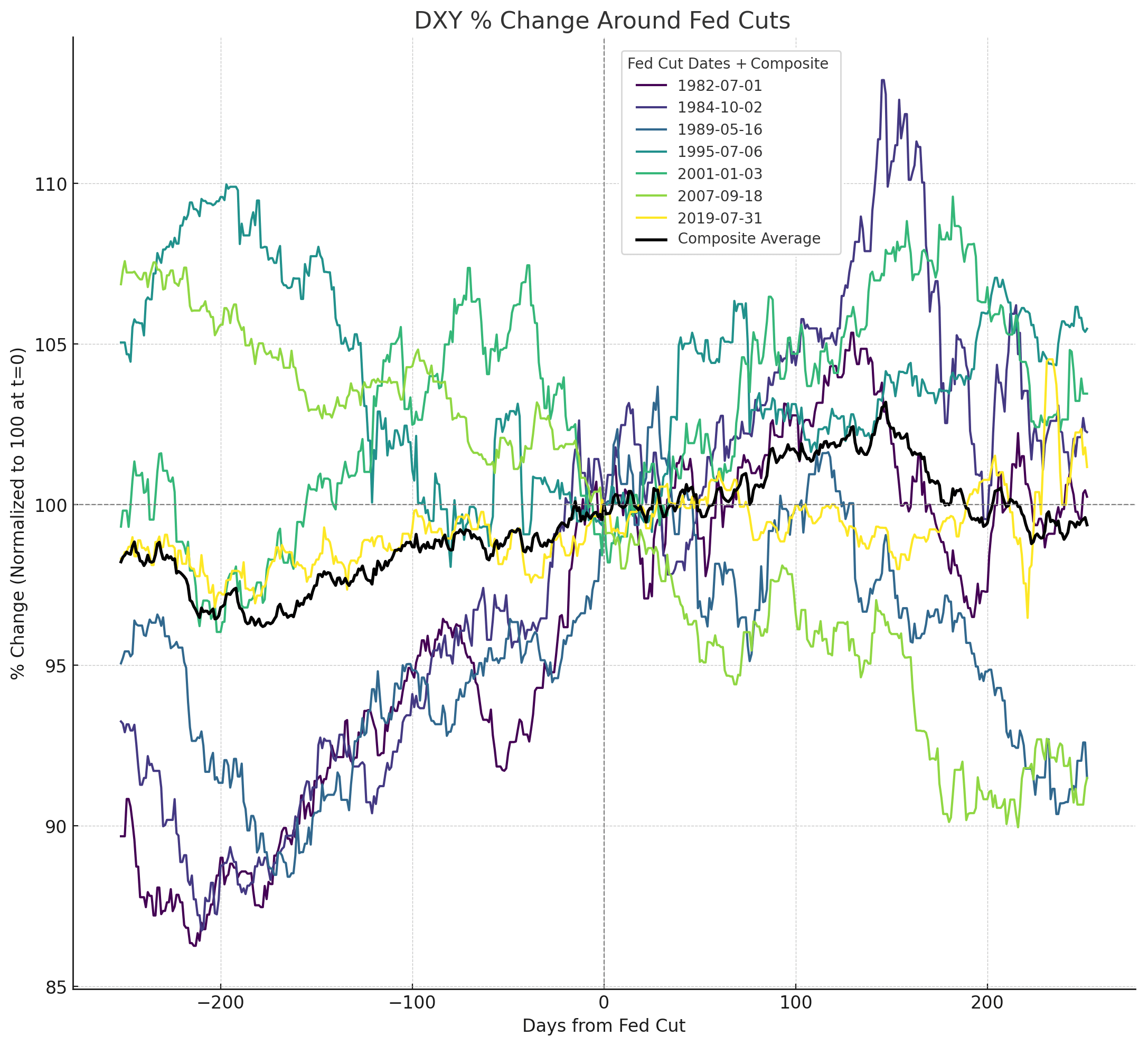
Fed Rate Cut Key Points
- The Fed dates back more than a century to 1913, but the modern history of Fed interest rate policy started in 1982.
- Since then, there have seven unique interest rate cutting cycles, with varied impacts on EUR/USD, GBP/USD, USD/JPY, and the US Dollar Index (DXY).
- Historically, the US dollar has shown a modest tendency to gain value around Fed rate cuts, especially in the six months before and six months after the Fed starts easing policy.
The History of the Federal Reserve and Basics of Monetary Policy
The central bank of the United States, the Federal Reserve, dates back more than 110 years to 1913.
The Fed was initially created to promote economic stability and break the cycle of frequent, recurring financial crises and widespread bank failures (1907, 1901, 1896, 1893, 1890, 1884, 1873…). At its core, the Federal Reserve system was designed to provide a more elastic currency, enhance financial stability, and mitigate the impact of banking panics.
Over its century+ history, the Fed has evolved dramatically into a complex institution with a number of key responsibilities, highlighted by its dual mandate to pursue “maximum employment and stable prices.” As many traders know, its primary tool for achieving those goals is monetary policy, or adjusting interest rates and changing the money supply.
Put simply, when the economy is struggling and employment falls, the central bank generally cuts interest rates and increasing the money supply to promote more growth. Conversely, when the economy is overheating and inflation runs the risk of becoming entrenched, the Fed will raise interest rates and reduce the money supply in an effort to “cool off” the economy.
The History of Federal Reserve Interest Rates
While the Fed has always sought to smooth out the business cycle through adjusting interest rates, it’s approach to tweaking interest rates has changed substantially over the decades. As any financial historian will tell you, the Federal Reserve made many mistakes early in its history, including raising interest rates in the early 1930s and likely exacerbating the severity of the Great Depression.
The modern history of Federal Reserve interest rate policy can be properly dated back to 1982. Before that period, the US monetary system was either based on the gold standard (pre-1933), a pseudo-gold standard called the Bretton Woods system (until 1971), volatile unannounced changes to the Fed’s open market operations (1971-1979), or focused on adjusting the money supply, rather than interest rates (1979-1982). Thus, though we do have reliable records of the Federal Funds interest rate dating back to the mid-1950s, it was not the unambiguous, primary tool for adjusting monetary policy that we know today until the early 1980s:

Source: FRED
The Modern History of Fed Rate Cut Cycles
Since 1982, the Fed has generally tried to avoid surprising markets and manage expectations by publicly announcing its interest rate decisions and, more recently, sharing its current expectations for future economic variables like growth, inflation, and unemployment, as well as interest.
With the Fed seemingly on the verge of a new interest rate cutting cycle as we go to press, I wanted to examine what has happened to major currency pairs both in the year before and year after the first interest rate cut of a cycle. For the purposes of this analysis, an interest rate “cycle” is defined as a 100bps (1%) move higher or lower in interest rates. By this definition, there have been seven unique easing cycles since 1982, starting on the following dates:
- 7/1/1982
- 10/2/1984
- 5/16/1989
- 7/6/1995
- 1/3/2001
- 9/18/2007
- 7/31/2019
As with any study of historical prices, there is no guarantee that future interest rate cycles will play out similarly, especially with a relatively small sample size, but this type of analysis can be a useful tool for setting expectations and identifying ranges of potential outcomes.
Impact of Fed Rate Cuts on EUR/USD
Starting with the world’s most widely-traded currency pair, EUR/USD has seen broadly divergent returns both in the year before and year after the first Fed rate cut of a new easing cycle:
- The 1980s cycles (1982, 1984, 1989) featured big EUR/USD drops (7%+) in the year before the Fed cut interest rates.
- Returns heading into the first Fed rate cut of an easing cycle have generally been strong over the past quarter-century, varying from -2% (2019) to +12% (2001)
- EUR/USD returns in the year after the Fed starts cutting rates have varied from +17% (1989) to -4% (1995 and 2001)
- On average, EUR/USD has fallen -1% in the year before the Fed starts cutting interest rates and risen 3% in the year after.

Source: TradingView, StoneX
Impact of Fed Rate Cuts on GBP/USD
Turning our attention to British pound, GBP/USD has seen a more consistent bearish trend both in the year before and the year after the start of a new Fed rate easing cycle:
- GBP/USD has lost value in the year leading up to the first Fed rate cut in six of the past seven cycles.
- The strongest yearly gain ahead of a Fed rate cut was just +3%.
- GBP/USD has gained value in the year after an initial Fed rate cut in three of seven prior instances but those gains were limited (below +3%) relative to the historical max loss (-13%)
- On average, GBP/USD has fallen -5% in the year before the Fed starts cutting interest rates and lost another -2% in the year after.

Source: TradingView, StoneX
Impact of Fed Rate Cuts on USD/JPY
When it comes to USD/JPY, the returns around Fed rate cuts have been variable, with a slight positive average both in the year before and after the start of a new easing cycle:
- The mid-90s was a particularly wild period for USD/JPY, with the pair losing -12% heading into the first Fed rate cut in 1995 only to surge +22% in the year after.
- The worst year-after-a-Fed-cut return for USD/JPY was in 2007, when the pair fell by more than -10%
- Pre-Fed-rate-cut returns vary from +10% to -12% over the year, with post-Fed-rate-cut returns spanning the -10% to +22% range
- On average, USD/JPY has gained 1% in the year before the Fed starts cutting interest rates and gained another 2% in the year after.

Source: TradingView, StoneX
Impact of Fed Rate Cuts on the US Dollar Index (DXY)
Using the US Dollar Index (DXY) as a broad measure of the value of the world’s reserve currency, we can draw the following general conclusions:
- The US dollar can both rally or fall substantially heading into a Fed rate cut, with year-ahead returns varying from +10% to -7%.
- Likewise, the start of a new Fed rate cut cycle doesn’t necessarily lead to a consistent reaction in the greenback, with year-later returns falling in the -8% to +6% range.
- The clearest trend in the average performance of the US dollar has been a general period of strength in the six months before a Fed rate cut (+3% on average) to six months after (+2%) on average.

Source: TradingView, StoneX
How do Fed Rate Cuts Impact the Forex Market?
Perhaps contrary to popular opinion, the start of a new Fed rate cut cycle has NOT been a consistent bearish catalyst for the US dollar; if anything, the historical track record shows a modest bullish trend in the greenback, especially in the six months before and six months after the Fed starts easing policy.
Time will tell if future cycles follow the historical tendencies, but by better understanding the range of potential outcomes, readers can plan their outlooks for the coming year+ with more confidence.
-- Written by Matt Weller, Global Head of Research
Follow Matt on Twitter: @MWellerFX










